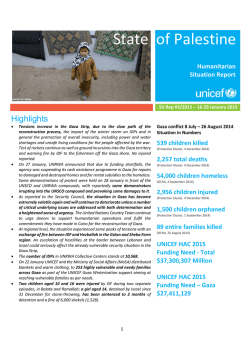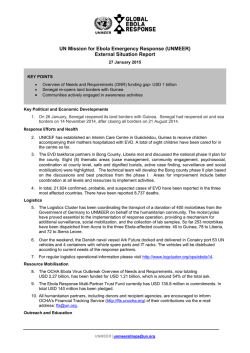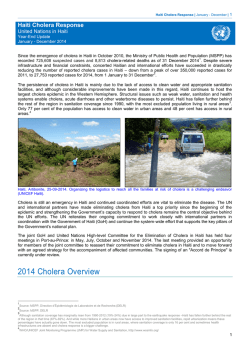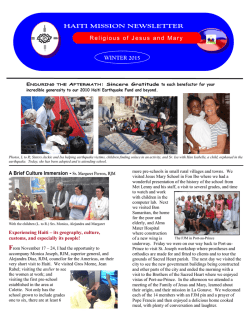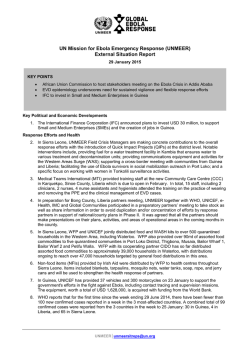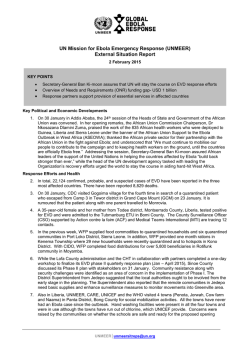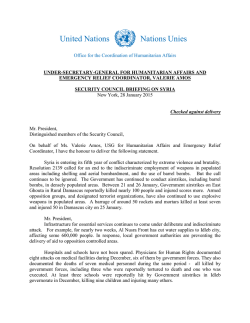
Current appeal [PDF]
2014 2015 ©UNICEF Haiti/2010/Dormino Humanitarian Action for Children Total affected population: 10 million Haiti Total affected children (under 18): 4.3 million Despite a reduction in the reported number of cholera cases in Haiti in 20141, an outbreak of the disease remains a threat in the country, including an ongoing outbreak of infections in the West Department (the most populous department) demonstrating that continuous efforts are still required to reduce cholera transmission. Haiti was also hit in 2014 by an outbreak of Chikungunya fever, affecting some 64,695 persons, including 5,000 children under age 5.2 As of October 2014, almost 94 per cent of Haitians displaced after the 2010 earthquake had left displacement sites. Out of 85,432 persons still living in the 123 Internal Displaced Persons (IDP) camps in Port-au-Prince area, approximately 12,7733 men, women and children do not have access to appropriate toilets. Despite a reported drought situation in the Northwest Department in early 2014, food security has reportedly improved due to a good spring harvest. Heavy rainfall in November caused flooding in the North and Northwest Departments affecting about 15,000 households as well as crops. This flooding could negatively impact next year’s harvest in these areas, with a resulting decline in household economy and overall nutritional status. Humanitarian strategy for 2015 In 2015, UNICEF will ensure continuous support to the national cholera elimination plan, supporting six NGO partners and the Government in delivering WASH rapid response and daily surveillance in areas at risk during the dry season (December to May) aiming at reducing the transmission before the rainy season starts in June 2015. UNICEF will continue to work closely with PAHO and the Ministry of Health to undertake a new vaccination campaign targeting 313,000 people. The future of the remaining IDP camps in Port-au-Prince area is not well defined although the Government’s official willingness is to close all the camps by 2015. To attend to humanitarian needs there and to avoid deterioration in living conditions, where there is also an increased risk of resurgence of cholera cases, UNICEF will extend its support to Government (DINEPA4) to ensure appropriate sanitary living conditions for displaced persons. In the area of WASH sector coordination efforts, UNICEF will support the transition of this function to the Government. Information management mechanism and capacity, DINEPA SOP development, rapid needs assessment capacity building and 1 emergency WASH guidelines production will be the main objectives of this support. UNICEF’s nutrition strategy continues to focus on preventing the deterioration of the nutritional situation through micronutrients supplementation (targeting 600,000 children), and on supporting the treatment of children with severe acute malnutrition (SAM) through capacity building for the Ministry of Health, including monitoring nutritional status and providing treatment for 20,000 children with SAM under-five in 2015. The priority for child protection is to continue strengthening the capacity of the Institute of Social Welfare and Research to better address the protection needs of children during emergency situations at national and departmental levels, as well as raising awareness of the disaster-affected population about CP risks and response measures during emergencies. UNICEF also aims to increase collaboration with the Ministry of Education to promote disaster resilience through retrofitting 150 schools making them more disaster resistant (safe learning facilities); school disaster management; and DRR education. To foster people’s resilience, social protection mechanisms will be Since the beginning of the cholera outbreak in October 2010, there have been 712,330 suspected cholera cases, and 8,655 cholera deaths reported as of 1 November 2014. There was a significant decrease in cholera cases in 2014: 14,869 suspected cases and 132 deaths for the year as of 1 November 2014, compared to 49,099 suspected cases during the same period in 2013. 2 Ministry of Health, June 2014 3 IOM, DTM October 2014 4 The National Directorate for Water and Sanitation Total people to be reached in 2015: 1.23 million (48 per cent adults) Total children to be reached in 2015: 750,000 (600,000 under age 5 +) 150,000 under age 18) 2015 Programme Targets Child Protection 100 Institut du Bien-Etre Social et de Recherches (IBESR) social workers with capacity on prevention of separation, family tracing, and reintegration equipped to provide psychosocial support 50,000 disaster-affected people receive information about protection risks and how to protect children during emergency situations Education 115,000 primary school aged children are sensitized on DRR 2,700 teachers and education inspectors trained on DRR 150 schools in disaster-prone areas are retrofitted/reinforced Nutrition 20,000 children under 5 suffering from SAM receive treatment 600,000 children under 5 provided with micronutrient supplementation Health 313,000 vulnerable people receive cholera vaccination 50,000 disaster-affected people have access to appropriate health services WASH 70,000 internally displaced persons provided with sanitation services in camps 400,000 people in cholera-affected areas benefit from a complete WASH response package Humanitarian WASH sector coordination by DINEPA is effective by end 2015 Social Protection 50,000 disaster-affected people are able to meet basic non-food needs with improved access to services in emergency situations 500 extremely vulnerable households benefit from cash transfer to meet their basic needs in emergency situations www.unicef.org/appeals/haiti implemented in three Communes through conditional cash transfer based on vulnerabilities assessment results and household’s development results. Results 2014 With $22,157,571 of funds available as of mid-November (of which $7.6 million was carried forward from 2013), or roughly 52 per cent of the $42,366,400 appeal, UNICEF and partner response to cholera control focused on immediate needs while simultaneously strengthening the capacity of government partners. As part of the cholera response plan, 363,267 persons living in affected areas were sensitized and received cholera kits and/or gained access to improved water sources. Some 184,517 persons received two doses of the cholera vaccine between August and September 2014. UNICEF also provided resources to ensure appropriate access to sanitation for 106,446 people in camps. UNICEF supported the Ministry of Health’s response to the Chikungunya epidemic, including the distribution of 108,000 paracetamol doses to patients and the provision of micronutrient supplementation to 513,839 children under age five. UNICEF supported training on disaster risk reduction (DRR) for teachers, inspectors and children, and supported the roll-out of pilot projects testing in 14 schools in Port-au-Prince as disaster risk reduction ‘hubs’. UNICEF also supported DINEPA to take the lead in the WASH sector coordination in the transition away from the cluster approach. 2014 PROGRAMME TARGETS AND RESULTS Cluster 2014 Targets Cluster 2014 Results UNICEF UNICEF 2014 Targets 2014 Results5 NUTRITION Children under 5 with SAM admitted into therapeutic feeding programme Children under 5 receiving micronutrient supplementation HEALTH Populations in high-risk areas receive 2 doses of the cholera vaccine Disaster-affected camp and non-camp 2014 populations ProgrammeinTargets and Results settings receive preventative and curative health interventions6 20,000 7,145 1,500,000 513,839 200,000 184,517 100,000 22,769 134,000 106,446 450,000 363,267 150,000 50 50,000 50,000 5,000 0 40,000 6,909 WATER, SANITATION AND HYGIENE Populations living in camps access safe sanitation services People in rural and urban areas of cholera persistence benefit from sensitization, cholera supplies (cholera kits, aquatabs), rehabilitation of water points, protection of water sources and wells, hygiene promotion, sanitation and access to safe water CHILD PROTECTION Children affected by an emergency benefit from psychosocial support Non-food items pre-positioned for families affected by an emergency Unaccompanied and separated children benefit from family tracing and reintegration follow-up EDUCATION Primary school aged children are sensitized on DRR and are able to resume learning following an emergency7 145,000 Funding requirements Sector UNICEF is requesting US$22,000,000 to meet the humanitarian needs of children and women in Haiti in 2015. With this additional funding, UNICEF will be able to sustain the level of surveillance and rapid response required for each case of cholera in order to ultimately eliminate the disease. Funding is also required to build the national capacity in responding to crises, as well as to create the conditions for reinforcing resilience in communities. UNICEF aims to leverage the UN transition appeal strategy to strengthen the convergence between humanitarian action and long-term solution. >145,000 2015 Requirements (US$) Nutrition 4,800,000 Health 2,000,000 Water, Sanitation & Hygiene Child Protection 700,000 Education 3,000,000 Clusters transition support Total 11,000,000 500,000 22,000,000 5 As of 21 November 2014. In addition, medical supplies for 50,000 people in 10 departments has been pre-positioned. 7 There are 6,909 direct beneficiaries from pilot projects, but about 115,000 additional students indirectly benefiting from training, thanks to the training of 2,300 teachers who are able to deliver key messages. 6 For further information please contact: Marc Vincent Representative, Haiti Country Office Port-au-Prince, Haïti Tel + 509 37027916 E-mail: [email protected] Yasmin Haque Deputy Director, Office of Emergency Programmes UNICEF, New York Tel +1 212 326 7150 E-mail: [email protected] Olav Kjørven Director, Public Partnerships Division (PPD) UNICEF, New York Tel: +1 212 326 7160 Email: [email protected]
© Copyright 2026
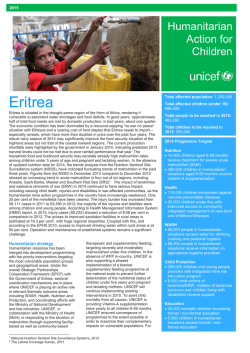
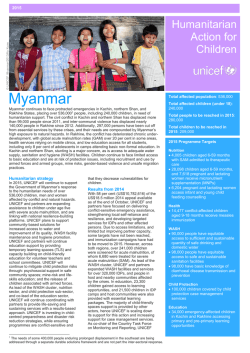
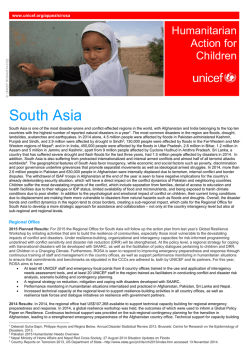
![Current appeal [PDF]](http://s2.esdocs.com/store/data/000470301_1-1a2ac0338c7b87d842a9839e11e746d1-250x500.png)
![Current appeal [PDF]](http://s2.esdocs.com/store/data/000456387_1-84443a4282546a8fcd8c29f2bdd10a65-250x500.png)
